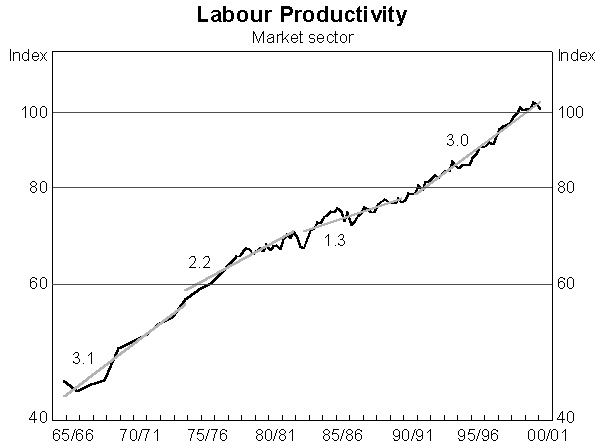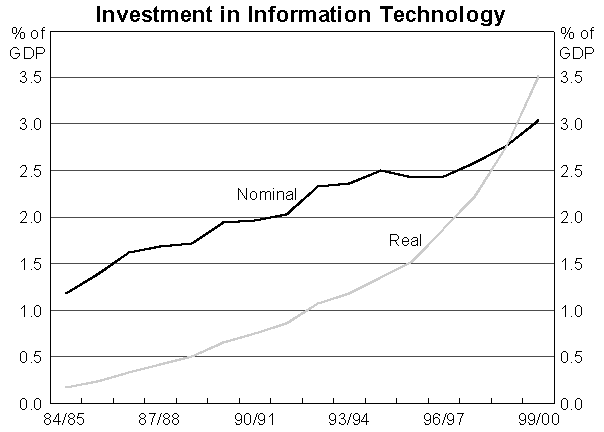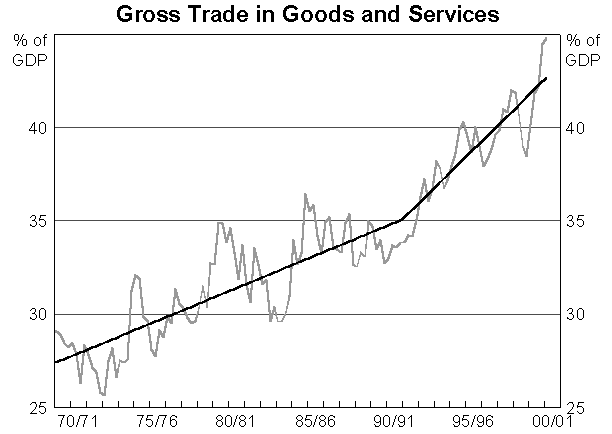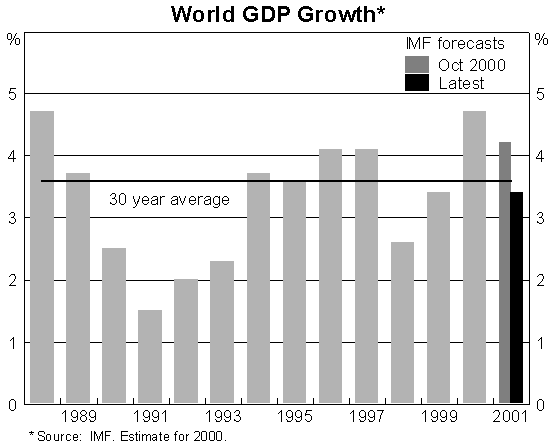Speech Economic Overview

Malcolm Edey
Head of Economic Analysis
Speech to the ABARE Outlook 2001 Conference
Canberra –
I would like to thank ABARE for the opportunity of addressing this forecasting conference today.
My specific task is to focus on short and medium-term prospects for the Australian economy. I will try to address that in two ways, first looking at longer-term trends in Australia's economic performance, and then moving on to some observations about the current situation. I should say at the outset that I plan to focus on the factors driving economic performance rather than on specific numerical forecasts.
Longer-run Trends
Productivity growth

There are a number of trends that one could nominate as likely to have a major bearing on Australia's longer-term economic prospects. In the time available, I would highlight just two. The first of these has been a sharp acceleration in productivity growth. This has been much remarked upon, both in Australia and abroad. We can measure this in a number of ways, but the simplest measure – labour productivity, defined as market-sector output per hour worked – grew at an annual rate of just on 3 per cent over the past decade. That was more than twice the rate of the previous decade, and faster than at any time since the late 1960s and early 1970s. A figure of 3 per cent might not sound much in the abstract, but it makes a big difference to living standards when sustained over a long period, and it compares favourably with the performance of other advanced countries (including the United States, often cited as a high achiever in this context).
The trend in productivity is in turn an important driver of overall economic performance. Usually we think of an economy's capacity to grow as being determined by growth in the available factors of production (labour and capital inputs) and the efficiency with which they are used. Other things equal, a higher productivity trend increases the economy's capacity for sustainable growth without inflation. Two questions come out of this.

Why did it happen? A plausible explanation for Australia's strong performance in this area would need to take account of several factors, including an important role for economic policies – in particular, the microeconomic reforms implemented in the last 10—15 years. Another important contributor is likely to have been the spread of new information technology – the much-vaunted ‘new economy’. This is a development that has been evident, to a greater or lesser degree, in all the advanced economies during the last decade or so. An important implication of this has been a change in the way businesses invest, with a rising share of investment being spent on computer hardware and software, and correspondingly less on other equipment and physical structures. It is not always widely appreciated that Australia ranks highly in international comparisons as to the rate at which this process is occurring. [1]
Will it continue? Time will tell, but there seem to be some good general grounds for optimism regarding productivity growth in Australia, which in turn augurs well for economic performance more generally. Many of the reforms implemented in the last 10—15 years can be thought of as enhancing the ongoing flexibility of labour and product markets, not just generating one-off efficiency gains. Hence, it seems reasonable to think they will contribute to a continued process of productivity improvement. As to the new economy, it is true that the gloss has come off its most visible element – the tech-stock boom – in the last year or so, but that is likely to bear little relation to the actual application of technology in transforming ordinary businesses. That process, it seems, is continuing unabated.
Openness to trade
The second of the longer-term trends I would highlight is the economy's increasing exposure to international trade. To some extent, this is related to the first point. It is plausible to think that increased openness to trade promotes higher productivity, especially in a relatively small economy. Trade is likely to strengthen competitive pressures that push domestic producers close to the frontier of best practice. It also allows producers to gain economies of scale by operating in larger markets.

A simple indicator of the extent of this process is the gross value of exports and imports as a share of GDP. In Australia, the trade share measured on this basis has increased from a bit over 25 per cent in the early 1970s to almost 45 per cent at present, and the rate at which this opening-up is occurring has, if anything, been accelerating.
One important driver of this process has been a reduction in industry protection.[2] Tariff protection can be thought of not only as discouraging imports, but also as imposing an effective tax on exports; hence, as tariffs are reduced, both exports and imports increase. This has clearly happened in Australia during the last decade or so, although other factors such as lower transport costs, and falling protection in overseas markets, will also have contributed.
It is interesting to note in this context that manufacturing has been the fastest-growing component of Australia's exports during the past decade – a trend that occurred at the same time as assistance for the industry was being reduced.[3] This has been accompanied by rapid growth in intra-industry trade, another sign of businesses becoming increasingly international in focus.
Another important dimension of the increased openness has been an ongoing shift in the direction of trade. The general trend towards increased trade with east Asia is well known. About 35 per cent of Australia's exports now go to non-Japan east Asia, up from 25 per cent just a decade ago. Exports to the region are still growing strongly and have more than made up the ground lost during the Asian crisis.
| 1990 | 2000 | |
|---|---|---|
| US and EU | 25 | 21 |
| Japan | 26 | 20 |
| ASEAN | 11 | 14 |
| Other East Asia | 15 | 22 |
| Rest of the world | 22 | 23 |
The Current Situation
Let me turn briefly now to the current situation. In doing so, I draw heavily on the Reserve Bank's most recent policy statement, released two weeks ago.
The statement notes that the Australian economy has slowed in recent months, coming after a period of unusually strong growth over the preceding three years or so. Some of the recent slowing has been a reflection of temporary factors, of which the most important has been the tax-related shift in the timing of housing construction activity. In net terms, these factors boosted growth in the first half of 2000, but reduced it in the second half. But even looking through the temporary factors, the underlying trend in domestic demand has moderated. At the same time, there has been a pronounced shift in the composition of growth, and the softer trend in domestic demand has been partly offset by strong growth in exports.

Looking ahead, the main sources of risk for the Australian economy are those associated with the international outlook. Domestically, there is little sign of the sorts of imbalances that have curtailed growth in the past. Wage growth remained moderate in recent periods, despite strong demand and high headline inflation figures; business profitability coming into the second half of 2000 was high; and there are no signs of an overhang of surplus business investment. Also, interest rates have remained relatively low – even before the February interest rate cut, they were close to or below cyclically average levels. And inflation in underlying terms is well contained.
On that basis the Australian economy seems as well placed as could be hoped to weather a shift in international conditions, such as the one currently occurring. Nonetheless, it would be difficult for Australia to remain unaffected in the event of a sharp slowdown in the global economy. At this stage, official forecasters such as the IMF are predicting that world growth in 2001 will be noticeably slower than last year, although still only slightly less than the long-run average. As usual, however, other observers offer a wide range of alternative opinions, with the key uncertainties centering on the United States, where some are expecting a more pronounced downturn. Whether that eventuates remains to be seen, but these international developments are likely to remain a key focus of attention in the year ahead.
Endnotes
International studies generally distinguish between the production and application of information technology. Australia has relatively little production in the technology sector but ranks highly in terms of its application by businesses and households. See for example, IMF World Economic Outlook, Sep 2000, Ch 2. [1]
The Productivity Commission estimates that the effective rate of assistance in manufacturing has come down from around 35 per cent in the early 70s to just 5 per cent now. [2]
Manufactured exports increased at an annual rate of 12 per cent in volume terms during the decade, compared with a (still impressive) annual growth rate of 8 per cent in total exports. [3]